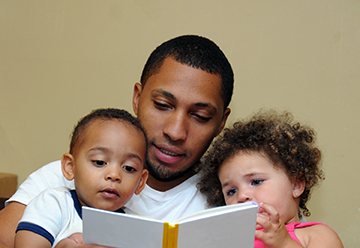What are some unique issues related to working with families of these children?
Page 4: Family Engagement: Collaborating with Families of Students with Disabilities
 The involvement of parents can be a powerful influence on their children’s educational success and as such is regarded as a best practice in early childhood instruction. In addition to helping them to understand the importance of maintaining their home language, teachers should collaborate with families because families:
The involvement of parents can be a powerful influence on their children’s educational success and as such is regarded as a best practice in early childhood instruction. In addition to helping them to understand the importance of maintaining their home language, teachers should collaborate with families because families:
- Are important partners in facilitating their children’s overall development
- Advocate for their children’s services from the time they are screened through their transition to kindergarten and beyond
- Are knowledgeable about their children’s skills and abilities in their home language
- Promote the use of the home language in the classroom, at home, and in the community
- Promote the continuity of services, interventions, and practices between home and school
Listen now as Rosa Milagros Santos talks about the importance of collaborating with families (time: 1:45).

Rosa Milagros Santos, PhD
Professor, Special Education
University of Illinois at Urbana-Champaign
Transcript: Rosa Milagros Santos, PhD
In early childhood, we really include families or really think of families as an important part of what we do with young children, whether they are served in schools, in programs, or whether they’re served in homes. In every aspect of what we do with children, we have to have the families in there. For families who speak different languages other than English in their homes, it’s really important to collaborate with that family to understand what is the child’s exposure to English at home or to their home language? What do the families value in terms of, do they want their child to continue to learn their home language? What techniques are they using to help their child or their children learn their language, as well as the school language? Families are really a great source of information for the child, both in terms of getting more information about their child, as well as about things that they’ve tried at home that could be tried in schools.
For teachers, it’s really important for them to think about how the child is at home to help them understand why the child does what he does or she does in school. It’s really important for them to know what are some of the routines and activities that they do at home? When you’re dealing with a family from a different culture or who have different traditions and beliefs and practices, what is it that they do? Oh, they do evening prayers, or they do sundown prayers, or they feed all the children first before the adults.
Understand the context for why children do certain things, and a lot of it’s very culture-based, and so understanding what the children do at home will help teachers understand what is it that they carry on to school from their homes.
DEC Recommended Practices
The DEC Recommended Practices on working with families serve as a starting point for collaborating with a broad range of families, including those who have young EL children with disabilities. Although all the DEC Recommended Family Practices broadly apply to the families of young EL children with disabilities, the two listed below specifically refer to this population.
- F1. Practitioners build trusting and respectful partnerships with the family through interactions that are sensitive and responsive to cultural, linguistic, and socio-economic diversity.
- F8. Practitioners provide the family of a young child who has or is at risk for developmental delay/disability, and who is a dual language learner, with information about the benefits of learning in multiple languages for the child’s growth and development.
(DEC Recommended Practices, 2014)
Underscoring the DEC Recommended Family Practices are a variety of strategies that teachers can use to partner with families. Below are three important strategies that can lead to successful parent-professional collaborations, especially those involving young ELs with disabilities.
Build and maintain rapport with families: Teachers should develop positive relationships with families based on mutual trust, acceptance, and respect. To build rapport, teachers must begin with a sincere interest in getting to know the children and their families. This requires the teacher to know what language or languages are spoken at home and to do his or her best to share information in that language (e.g., important notices from school, daily child updates). Teachers can get to know the families by talking to them at drop-off and pick-up times or on the phone, and when feasible by visiting the families in their homes. Understanding a few key words and phrases in the home language can go a long way in signaling a teacher’s respect and interest. When teachers are required to communicate more than basic information, interpreters can prove indispensable. Teachers should understand that there are often stressors associated with being the family of a young child with a disability (e.g., financial, emotional, medical). Teachers should be non-judgmental in understanding the issues the families are facing, how they affect the child, and how the teacher can use this information to support them.
 Learn from families: In order for professionals to learn more about young ELs with disabilities and their families, they should ask the families questions about what is important to them for their child. These range from broad questions (e.g., “What would you like your child to accomplish in the next year?”) to specific questions (e.g., “What have you tried to help your child sit at the table during mealtime?”). In addition, teachers can learn about the child’s routines and activities in the home, as well as in the community. Teachers can use all of this information to address the child’s needs, plan instruction, and help the child be more successful in the classroom.
Learn from families: In order for professionals to learn more about young ELs with disabilities and their families, they should ask the families questions about what is important to them for their child. These range from broad questions (e.g., “What would you like your child to accomplish in the next year?”) to specific questions (e.g., “What have you tried to help your child sit at the table during mealtime?”). In addition, teachers can learn about the child’s routines and activities in the home, as well as in the community. Teachers can use all of this information to address the child’s needs, plan instruction, and help the child be more successful in the classroom.
Create welcoming classrooms: Teachers should create classroom environments that are welcoming not only to the children but also to their families. Some ways they can do this include:
- Establishing an open door policy whereby families can feel free to drop in anytime
- Creating bulletin boards that include pictures of families or that highlight the multiple languages of the classroom (e.g., the word “hello” displayed in all of the classroom’s languages)
- Ensuring that classroom materials (e.g., posters, toys, dramatic centers) are representative of the student’s heterogeneity (e.g., their disability, culture, ethnicity)
- Inviting families to attend parent-teacher conferences
- Creating volunteer opportunities in the classroom
- Asking families to share their language, culture, knowledge, skills, talents, and hobbies with the class
- Using families’ preferred modes of communication (e.g., emails, texts, phone calls, notes)
A look inside Mrs. Raymond's classroom
At the beginning of the school year, Mrs. Raymond asks families to share family photos. In a few cases, Mrs. Raymond takes a picture of the family using her camera phone during her home visit or when the family attends an open house or other school event. Mrs. Raymond carefully posts these photos around the room so that the children can see their families throughout the day. This can be especially effective for children who are experiencing separation anxiety. Displaying family photos also gives families a sense of belonging and makes them feel welcome.